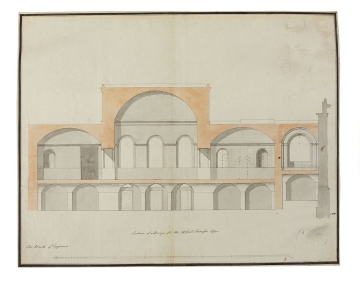
Browse
Reference number
Purpose
Aspect
Scale
Inscribed
Signed and dated
- datable to 1798-99
Hand
Notes
Four main piers, corresponding to the four main piers in the hall above, and eight smaller piers, for additional support, form segmental arches supporting the foundations of the hall. SM volume 74/64 shows the structure of the piers, made of stone and iron tie-rods with a column-flue running through the centre. This drawing indicates doors at the north end under the central dome of the hall, suggesting that perhaps the cellar was used for storage.
This drawing also shows an alternative design scheme for the Consols Transfer Office without a central lantern or clerestory windows, reducing the height of the end-bays.
Bailey (1792-1860) was an office assistant between 1806 and 1837 and then from 1837 to 1860 he was the curator. He took on a role of inscriber within the office adding dates and locations to drawings at a later date for referencing. This could possibly have led to inaccuracies, especially if he added the information after Soane's demise in 1837 and so one should consider these inscriptions with caution.
Level
Sir John Soane's collection includes some 30,000 architectural, design and topographical drawings which is a very important resource for scholars worldwide. His was the first architect’s collection to attempt to preserve the best in design for the architectural profession in the future, and it did so by assembling as exemplars surviving drawings by great Renaissance masters and by the leading architects in Britain in the 17th and 18th centuries and his near contemporaries such as Sir William Chambers, Robert Adam and George Dance the Younger. These drawings sit side by side with 9,000 drawings in Soane’s own hand or those of the pupils in his office, covering his early work as a student, his time in Italy and the drawings produced in the course of his architectural practice from 1780 until the 1830s.
Browse (via the vertical menu to the left) and search results for Drawings include a mixture of Concise catalogue records – drawn from an outline list of the collection – and fuller records where drawings have been catalogued in more detail (an ongoing process).

